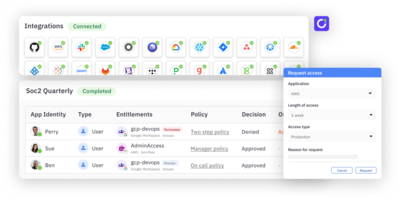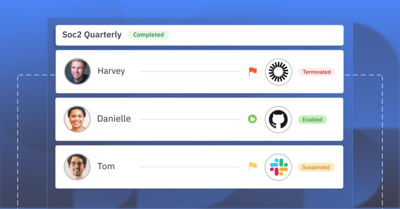For technology and security leaders, the integration of artificial intelligence into identity and access management (IAM) presents a powerful opportunity to automate regulatory compliance processes, giving leaders time to focus on the real prize: security.
AI can automate controls, monitor access in real-time, and maintain a state of continuous compliance that is impossible with legacy, manual processes.
This guide will break down how AI can be leveraged to achieve and maintain compliance and provide a set of best practices for creating a resilient and trustworthy strategy.
How AI helps achieve and maintain compliance
Artificial intelligence is a powerful ally in achieving and maintaining regulatory compliance. It transforms the core processes of governance from periodic, manual fire drills into a continuous, automated, and auditable function.
Continuous controls monitoring
Traditional compliance checks are point-in-time snapshots, often conducted quarterly or annually, that miss what happens in between. AI enables continuous monitoring, ensuring your access controls are operating as intended at all times. This provides a real-time view of your compliance posture, allowing for immediate detection and remediation of any deviations.
💡Pro tip: Leverage AI-driven monitoring to get ahead of configuration drift. For example, AI can automatically detect and alert you if a critical IAM policy in your AWS environment is changed in a way that violates your internal compliance framework, allowing you to fix it in minutes, not months later during an audit.
Intelligent and auditable access reviews
Access certifications are a key requirement for regulations like SOX, but the manual process is famously prone to rubber-stamping. AI makes these reviews meaningful by providing business managers with the data-driven context they need to make an informed decision.
Practical example: During an access review for a critical financial application, AI can provide the reviewer with simple, powerful recommendations: “Certify these 10 users whose access aligns with their peers and daily usage. Scrutinize these 2 users who have high-privilege access they have not used in over 90 days.” This focuses human attention where it’s most needed and creates a more defensible audit trail.
Learn more → Five Ways to Streamline SOX Compliance with ConductorOne
Automated evidence gathering and reporting
One of the most expensive parts of any audit is the manual, time-consuming effort of gathering evidence. AI can automate the collection and collation of access data, generating the detailed, high-confidence reports required by auditors on demand.
💡Pro tip: Choose an IAM solution where the AI’s justifications for its decisions are automatically logged. This allows you to instantly generate a report for an auditor that not only shows what access a user has, but provides a data-driven reason why the system has determined that access is still appropriate and low-risk.
Proactive SoD and policy violation detection
AI can go beyond the static, pre-defined rules of traditional Separation of Duties (SoD) monitoring. By analyzing patterns of behavior and the relationships between different permissions, it can provide an early warning of potential compliance violations.
Practical example: A static SoD rule might check if a user can both create a vendor and approve a payment. An AI can go further by flagging a user who, while not having both permissions directly, has requested and been granted temporary access to both capabilities within a short timeframe—a pattern that could indicate an attempt to circumvent controls.
💡Customer story → How Instacart is using AI to achieve zero standing privileges
5 Best practices for a defensible AI-powered compliance strategy
Building a compliance program that can withstand the scrutiny of auditors in the age of AI requires a deliberate focus on governance, transparency, and continuous validation. The following best practices provide a strategic framework for creating a resilient and defensible program.
1. Prioritize explainable AI
Your platform should be able to provide clear, human-readable justifications for every significant, AI-driven decision.
2. Establish a human-in-the-loop governance model
Ensure that a human has the final approval authority for all high-risk, AI-driven compliance and access decisions. While the AI can provide powerful, data-driven recommendations, the ultimate accountability for a critical action—like certifying access to a key financial system—should rest with a designated human owner to create a clear chain of accountability.
3. Maintain comprehensive audit trails of the AI itself
Your audit logs must evolve. They should include key data points and reasoning that led to any decisions made by AI. An auditor should be able to see a log that says not just ‘access certified,’ but ‘access certified based on continuous usage and alignment with the user’s peer group.’
Learn more → Understanding IT Compliance Audits: What to Expect, How to Prepare, and Best Practices
4. Start with high-value, low-risk use cases
Begin your AI-in-compliance journey by applying the technology to augment a process like user access reviews. This allows your organization to gain immediate value from AI-driven recommendations in a lower-risk environment. It provides an opportunity to build trust in the system, validate its accuracy, and refine the models before applying AI to more critical, real-time access control decisions.
Learn more → User Access Management: How It Works and Key Components
The platform for a defensible, AI-powered compliance program
The benefits of AI in compliance are immense, but they come with significant risks. ConductorOne is the modern identity governance platform designed to provide the necessary transparency and control, allowing you to leverage the power of automation while mitigating the new compliance risks that AI introduces.
We help you build a defensible, audit-ready program by focusing on the core principles of trustworthy AI:
- Delivering clear explainability: Our platform is designed to be transparent. Every automated action and AI-driven recommendation includes a clear, human-readable justification in the audit log. This ensures you can provide auditors with the specific reasoning behind every decision.
- Enabling human-in-the-loop governance: Our platform allows you to configure workflows so that any high-risk, AI-driven decision is routed to a designated human owner for a final, one-click approval, ensuring you always have ultimate control.
- Providing a comprehensive audit trail: ConductorOne gives you a centralized, always-on view of all access controls. This allows you to generate high-confidence reports on demand, shifting your organization from a reactive audit fire drill to a state of continuous compliance.
“ConductorOne is extremely customizable, very powerful, and doesn’t make assumptions about how your organization works.” – Matthew Sullivan, Infrastructure Security Team Leader at InstaCart.
Stop choosing between intelligent automation and auditable compliance. With ConductorOne, you get both.
To learn more about ConductorOne, book a demo.
FAQs:
How is the EU’s AI Act expected to impact the use of AI in IAM?
The EU’s AI Act is expected to have a significant impact by classifying certain AI systems as high-risk, a category that will likely include systems used for critical infrastructure and employment—both of which intersect with IAM. For these systems, the Act will mandate strict requirements for risk management, data quality, transparency, and human oversight. This means that having an IAM platform with built-in explainability and human-in-the-loop governance will move from a best practice to a legal necessity for organizations operating in the EU.
How can an organization prove to an auditor that its AI is not biased?
Proving a lack of bias requires a continuous, multi-faceted approach. First, you must be able to show an auditor that your training data was reviewed for and cleansed of known biases. Second, and more importantly, you need to conduct regular outcome testing on the live model. This involves analyzing the AI’s decisions to see if they disproportionately affect any specific group and documenting any corrective actions taken. This shifts the focus from just the data to the real-world performance of the AI.
What is the first step to ensuring our current IAM program is ready for AI-driven compliance?
The most critical first step is to centralize and normalize your identity data. AI-driven compliance is entirely dependent on having a clean, unified view of all identities and their access across your entire application estate. Before you can leverage AI, you must first invest in a modern identity governance platform that can break down data silos and create the single, authoritative source of truth that the AI will need to be effective.




